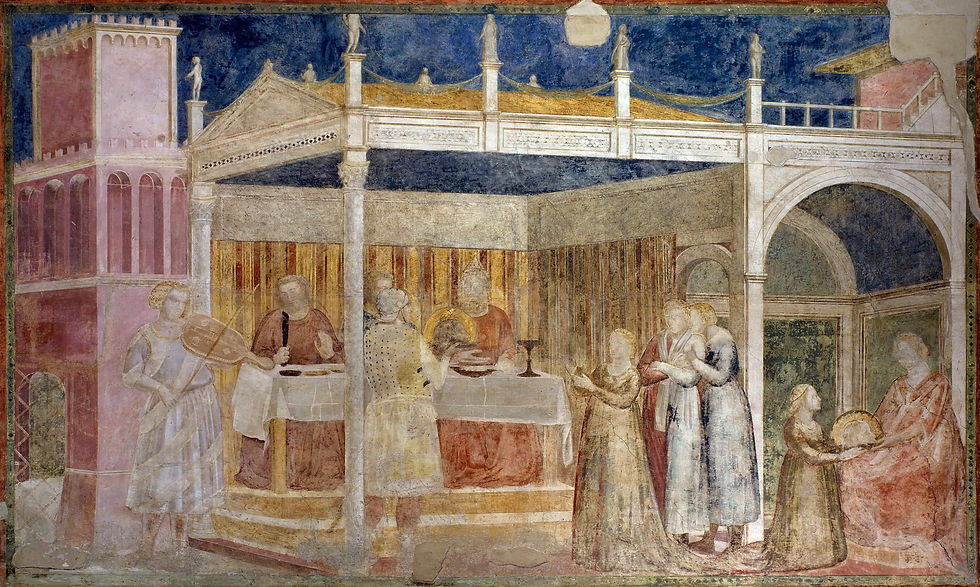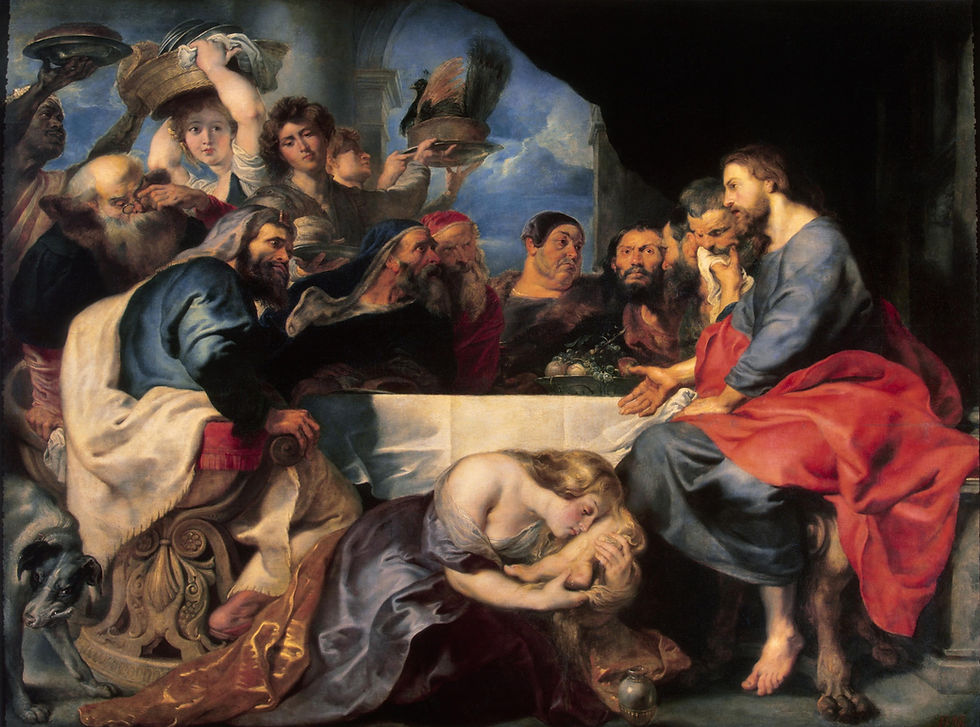Marriage at Cana | Feast of Herod | Meal at Simon the Pharisee | Allegories and Parables | Last Supper | Supper at Emmaus | Harvest of the Earth | Redemption
Herod’s Feast: a dark family drama turns to tragedy

THE FEAST OF HEROD
Giotto dit Bondone (1267-1337)
1320 - Capella Peruzzi, Santa Croce, Florene, Italy
John the Baptist (who baptised Christ) is imprisoned after denouncing the incestuous marriage of ruler Herod Antipas with Herodias, his own niece and wife of his half-brother. Salome, Herodias’ daughter, dances for banquet’s guests to the dulcet tones of a vielle (a medieval string instrument). Her performance bewitches the king, who offers her anything she wants in return. Upon the advice of her mother, Salome demands the head of John the Baptist, which she presents to the king. She then passes it to Herodias as the musician continues to play.

THE FEAST OF HEROD AND THE BEHEADING OF THE BAPTIST Giovanni Baronzio, ca. 1330/35 - The Metropolitan Museum of Art, New York

SALOME PRESENTING THE HEAD OF ST JOHN THE BAPTIST TO KING HEROD Ulm School, ca. 1450 - Alte Pinakothek, Munich, Germany

SALOME ASKING HEROD FOR THE HEAD OF SAINT JOHN THE BAPTIST Giovanni di Paolo, 1455/60 - Art Institute of Chicago

THE FEAST OF HEROD AND THE BEHEADING OF SAINT JOHN THE BAPTIST Benozzo Gozzoli, 1461/62 - National Gallery Of Art, Washington

HEROD'S BANQUET Pedro García de Benabarre and workshop ca. 1470 - Museu Nacional d'Art de Catalunya, Barcelona, Spain

HEROD'S BANQUET Lucas Cranach the Elder, 1531 - Wadsworth Atheneum Museum of Art, Hartford, CT, United States

SALOME RECEIVES THE HEAD OF JOHN THE BAPTIST Michelangelo Merisi da Caravaggio, ca. 1609/10 - National Gallery, London / 7

THE FEAST OF HEROD Peter Paul Rubens, ca. 1635/38 - Scottish National Gallery Edinburgh, United Kingdom

FEAST OF HEROD Mattia Preti, 1656-61 - The Toledo Museum of Art, Toledo, OH, United States
> Click on the icons for a closer look at the artworks
7. Alike other artists, Caravaggio retains the bare essentials of this tragic scene. The executioner, brutal in appearance, places John the Baptist’s head on Salome’s platter with disgust; the young woman’s empty expression and sideways glance are enigmatic. An aged servant crosses her hands in sorrow. The composition might appear simple at first glance, but it actually depicts a powerful physical and psychological interaction between the two main protagonists.
Bible text: New Testament, Marc VI, 17-29
"For Herod himself had sent forth and laid hold upon John, and bound him in prison for Herodias' sake, his brother Philip's wife: for he had married her. For John had said unto Herod, It is not lawful for thee to have thy brother's wife. Therefore Herodias had a quarrel against him, and would have killed him; but she could not: For Herod feared John, knowing that he was a just man and an holy, and observed him; and when he heard him, he did many things, and heard him gladly. And when a convenient day was come, that Herod on his birthday made a supper to his lords, high captains, and chief estates of Galilee; And when the daughter of the said Herodias came in, and danced, and pleased Herod and them that sat with him, the king said unto the damsel, Ask of me whatsoever thou wilt, and I will give it thee. And he sware unto her, Whatsoever thou shalt ask of me, I will give it thee, unto the half of my kingdom. And she went forth, and said unto her mother, What shall I ask? And she said, The head of John the Baptist. And she came in straightway with haste unto the king, and asked, saying, I will that thou give me by and by in a charger the head of John the Baptist. And the king was exceeding sorry; yet for his oath's sake, and for their sakes which sat with him, he would not reject her. And immediately the king sent an executioner, and commanded his head to be brought: and he went and beheaded him in the prison, And brought his head in a charger, and gave it to the damsel: and the damsel gave it to her mother. And when his disciples heard of it, they came and took up his corpse, and laid it in a tomb."
GALLERIES THE BLOOD OF CHRIST IN THE NEW TESTAMENT AND CHRISTIAN ICONOGRAPHY









